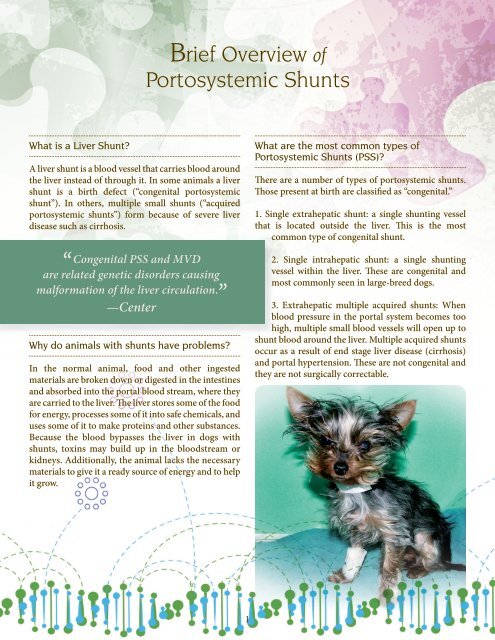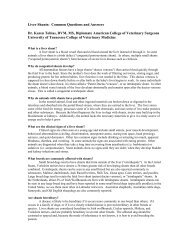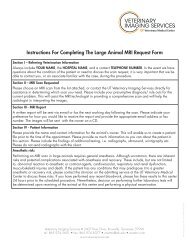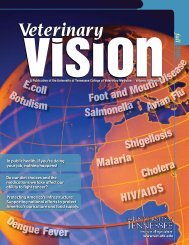Portosystemic Shunts - The University of Tennessee College of ...
Portosystemic Shunts - The University of Tennessee College of ...
Portosystemic Shunts - The University of Tennessee College of ...
Create successful ePaper yourself
Turn your PDF publications into a flip-book with our unique Google optimized e-Paper software.
Brief Overview <strong>of</strong><strong>Portosystemic</strong> <strong>Shunts</strong>What is a Liver Shunt?A liver shunt is a blood vessel that carries blood aroundthe liver instead <strong>of</strong> through it. In some animals a livershunt is a birth defect (“congenital portosystemicshunt”). In others, multiple small shunts (“acquiredportosystemic shunts”) form because <strong>of</strong> severe liverdisease such as cirrhosis.“Congenital PSS and MVDare related genetic disorders causingmalformation <strong>of</strong> the liver circulation.”—CenterWhy do animals with shunts have problems?In the normal animal, food and other ingestedmaterials are broken down or digested in the intestinesand absorbed into the portal blood stream, where theyare carried to the liver. <strong>The</strong> liver stores some <strong>of</strong> the foodfor energy, processes some <strong>of</strong> it into safe chemicals, anduses some <strong>of</strong> it to make proteins and other substances.Because the blood bypasses the liver in dogs withshunts, toxins may build up in the bloodstream orkidneys. Additionally, the animal lacks the necessarymaterials to give it a ready source <strong>of</strong> energy and to helpit grow.What are the most common types <strong>of</strong><strong>Portosystemic</strong> <strong>Shunts</strong> (PSS)?<strong>The</strong>re are a number <strong>of</strong> types <strong>of</strong> portosystemic shunts.Those present at birth are classified as “congenital.”1. Single extrahepatic shunt: a single shunting vesselthat is located outside the liver. This is the mostcommon type <strong>of</strong> congenital shunt.2. Single intrahepatic shunt: a single shuntingvessel within the liver. <strong>The</strong>se are congenital andmost commonly seen in large-breed dogs.3. Extrahepatic multiple acquired shunts: Whenblood pressure in the portal system becomes toohigh, multiple small blood vessels will open up toshunt blood around the liver. Multiple acquired shuntsoccur as a result <strong>of</strong> end stage liver disease (cirrhosis)and portal hypertension. <strong>The</strong>se are not congenital andthey are not surgically correctable.1
















